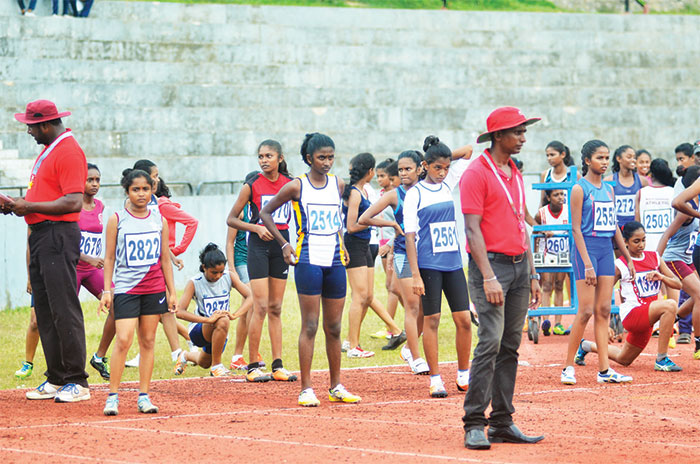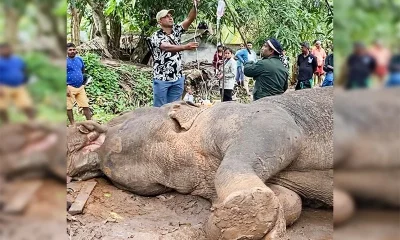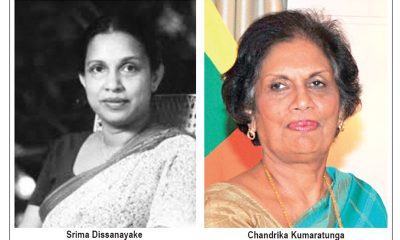Sports
An approach to improve school athletes’ present and future performance

by Nagalingam Ethirveerasingam. Ph.D.
Increasing Opportunities for Competition
Athletes in schools and those out-of-school do not currently have enough opportunities to participate in competitions. Scheduling competitions between schools within districts, and between districts for those who are out-of-school, will provide athletes with more opportunities to develop their skills and achieve a higher standard of performance. Factors that may present an obstacle to competitions include: 1) cost of ground preparation; 2) availability of qualified officials to conduct weekly dual athletic/sports meets between schools within the Education Zones; 3) lack of space for a 400m or 200m track in many schools; and 4) tradition requires the expensive practice of awarding certificates and trophies/medals in a formal presentation soon after the competition.
Many students now compete in the Inter-House athletic meets during the first term. Potential future athletes are identified at this time. The first three in an event compete in the Zonal or District meet. The first three from those meets are selected to compete in the Provincial school meet and those who place in the first three move on to compete in the National School Meet. Such an arrangement gives only one chance for an athlete to compete at the next level. The athlete who fails at the Inter-House meet or at any of the next levels has to wait another year to demonstrate his talent.
The National and the Public Schools athletic meets are conducted during the Second and Third Term. In effect a school athlete will at most have only three or four athletic meets a year. In the 1940’s and 1950’s I had only 4 meets per year. Those were: the Inter-House, the Jaffna School Sports Association meet, the Junior National meet, and the Open National meet.
In contrast school athletes in California (USA), then and now, have track meets between schools every week from February to April each year. That is about 12 meets during their track season. During the off-season they engage in conditioning and strengthening activities.
All schools in Sri Lanka have the traditional yearly Inter-House sports meet. Students engage in erecting and decorating sheds for their houses. It is a fun-filled school function where teachers and students interact outside the classroom. It includes the awarding of medals and certificates for winners and a lot of long speeches by dignitaries. Students get the experience oforganising an event and executing it by cooperating with fellow students and teachers.
Such a large-scale event and festive atmosphere is not needed for‘Dual Meets’ between schools. In secondary schools two school teams can compete, the results of the events are recorded, announced, and published. There is no need for speeches, certificates, medals, or trophies. The important thing is for the student to test his skills in competition with others of his age.
A New Approach
It is important for schools in the provinces to prepare Dual/Triangular athletic meet schedules for all schools including 1AB schools in their province at least twoyears in advance. The provinces should also prepare such a sports schedule for schools in other sports within their province. Any sports schedule prepared by the National Associations in sports such as cricket, athletics, or football should be in consultation with the Provincial Departments of Education and the schools. Provincial Departments of Education should ensure that the schedule of travel outside their provinces for sports events by school teams is structured in such a way to ensure that student class attendance is maximised and that classroom learning is not negatively affected.
Advent of Professionalism in sports
Since the time professional sportspersons were permitted to compete in the Olympic Games, athletes of national and international standard have been paid to take part and compete for prize money in their sports. The term “amateur” was dropped from international and national organizations names. The Sri Lanka Amateur Athletic Association, for example, was renamed Sri Lanka Athletics.
Athletes can now also receive sponsorship from shoe, clothing, or equipment manufacturers.
Although athletes in school are not currently permitted to lend their names to sporting goods and apparel manufacturers, the school/team can receive such sponsorship in the form of equipment and uniforms or monetary compensation. Schools also are able to garner funds by allowing businesses to advertise their products or services on the school grounds for a recurrent fee. Such income supplements the meagre allocation for sports from the Ministry of Education.
Athletes over 18 do not earn any income unless they are performing at national level. Many national level athletes in Sri Lanka can join the Sri Lanka Army, Air Force, or Police teams and get paid a monthly stipend of approximately Rs. 30,000. The only requirement is that the athlete regularly trains three to four hours per day and competes for them. The Sri Lanka Athletic Association provides similar monetary grants for selected national level athletes who are not paid by the armed forces. The three organisations depend on government funding for such programs. Some organisations in the business sector also sponsor athletes with varied requirements.
Promotion of Athletics at District Level
To promote District Athletics, it is important for District Athletic Associations to be funded by the government or the private sector. They could sponsor the first two athletes, in each event, who have potential to achieve national standing but do not have any sponsorship or other means of support. Payment of a monthly living allowance for the first two performers in each event in the district, similar to what the Army and Air Force pays the athletes who are enrolled with them, will help the district athlete to continue to develop their skills. This will allow the district level athlete to practice three to four hours a day and also attend job oriented tertiary courses. Such practice will ensure more opportunities for district level athletes to achieve National, South Asian, and Asian level standards. In exceptional cases the athlete may also be able to attain Olympic standards. It will also give opportunities for district level athletic coaches, who should also receive a stipend, to improve their coaching skills. An additional benefit is that the number of athletic officials will increase and they will acquire higher levels of organisational and officiating skills.
Promotion of Athletics at School Level
Since 2017, those who are not successful at the GCE O/L at age 16 and are thus not able to enter Grade 12, are required to continue in the Vocational Technical Program in 1AB schools. That is, a student who fails GCE O/L cannot dropout or be ‘Pushed Out’ at age 16. In effect education is compulsory for all until they are 19 years old. The above requirement was a recommendation made by the 2014 Northern Education System Review (NESR) and was adopted by the Northern Provincial Council. It was also adopted by the National Education Commission as a National Education Policy and accepted by the National Institute of Education (NIE). All athletes can now stay in school until they are 19 and benefit from continuing education while developing their skills in their respective sports. The NIE has prepared an excellent Vocational Technical Education Program for such students enrolled in Grade 12 and 13. Some 1AB schools have already adopted it. Others should do so in the near future. School age sportspersons can now continue their sports activities, even if they fail GCE O/L, and acquire skills to make them more employable.
School sports and athletic competitions are the responsibility of the Assistant Director of Education in the Provincial Department of Education. The Sri Lanka Athletic Association and the National Olympic Committee have no direct responsibility. However, they can provide advice, guidance, and distribute the funding that they receive from their respective international organisations such as the IAAF and International Olympic Committee.
(The writer Nagalingam Ethirveerasingam represented Sri Lanka at the 1952 and 1956 Olympic Games and is the first Sri Lankan to win an Asian Games gold)
Sports
Kithmuka anchors St. Servatius’ to draw

Forced to follow on after being dismissed for 111 runs, Risinu Kithmuka scored an unbeaten half century to anchor St. Servarius’ batting line up to force a draw to their Under 19 cricket encounter against S. Thomas’ at Mount Lavinia on Friday.
The dogged knock facing 121 balls, helped the visitor post 93 for five wickets at close.
In a match dominated by the home team, Aaron David’s century was the highlight for S. Thomas’. They posted 269 for four wickets at close on day one and declared on the overnight score.
Meanwhile at Kotahena, Mevan Dissanayake top scored with 91 runs inclusive of eight fours and three sixes for St. Benedict’s to post 295 for 9 declared against Sri Dharmaloka Kelaniya.
Results
Thomians dominate against St. Servatius’ at Mount Lavinia
Scores
S. Thomas’ 269 for 4 decl. in 73.3 overs (Jaden Amaraweera 40, Avinash Fernando 50, Aaron David 100n.o., Reshon Soloman 56; Lasindu Ramanayaka 2/87)
St. Servatius’ 111 all out 54.4 overs (Risinu Kithmuka 26, Thathsilu Bandara 20; Minon Warnasuriya 2/14, Chamash Gunawardena 2/24, Shanil Perera 3/18, Reshon Solomon 2/09) and 93 for 5 in 36 overs (Risinu Kithmuka 51n.o.; Aaron de Silva 2/30, Shanil Perera 3/23)
Bens 295 for 9 decl., Sri Dharmaloka 87/2 at Kotahena
Scores
St. Benedict’s 295 for 9 decl. in 56.4 overs (Mevan Dissanayake 91, Vihanga Rathnayake 42, Yohan Edirisinghe 31, Ayesh Gajanayake 49; Sathindu Praboda 4/98, Tharusha Mihiranga 2/66)
Sri Dharmaloka 87 for 2 in 25 overs (Senuka Pehesara 40, Kaveen Deneth 40n.o.; Ayesh Gajanayake 2/27)
by Reemus Fernando
Latest News
Subhan, Minhas star as Pakistan set up U-19 final with India

Pakistan marched into the final of the Under 19 Asia Cup with a clinical eight wicket win over Bangladesh in the rain-hit semi-final in Dubai, after a dominant bowling performance led by Abdul Subban set up a straightforward chase. The victory sets up a final clash against India, who won the first semi final against Sri Lanka earlier in the day.
Opting to field after winning the toss in the rain-reduced 27-overs-a-side contest, Pakistan made early inroads as Bangladesh slipped to 24 for 2 inside six overs. Captain Azizul Hakim offered brief resistance to steady the innings, but wickets continued to tumble at regular intervals.
Fast bowler Subhan was the standout with the ball, picking up four wickets to dismantle the middle order. From 55 for 2 in the 13th over, Bangladesh lost five wickets for just 38 runs, collapsing to 93 for 7. The lower order struggled to rebuild, and Bangladesh were eventually bowled out for 121 in 26.3 overs, with no batter able to convert a start into a big score.
In reply, Pakistan’s chase was smooth. After the early loss of opener Hamza Zahoor in the first over, Sameer Minhas anchored the innings with a composed, unbeaten 69, ensuring there were no further hiccups. He struck six fours and two sixes as Pakistan cruised to 122 for 2 with 63 balls to spare.
With this knock, Minhas took his tournament’s tally to 299 to be the highest run-getter.
Brief scores:
Pakistan 122 for 2 in 16.3 overs (Sameer Minhas 69*, Usman Khan 27; Samiun Basir 1-17) beat Bangladesh 121 in 26.3 overs (Samiun Basir 33; Abdul Subhan 4-20, Huzaifa Ahasan 2-10)by eight wickets
[Cricinfo]
Latest News
Malhotra, George fifties set up India vs Pakistan final

Vihaan Malhotra and Aaron George’s patient half-centuries helped India beat Sri Lanka in a rain-reduced game and set up an U-19 Asia Cup final with Pakistan.
It was a game where the momentum kept changing hands. India had Sri Lanka at 28 for 3 after opting to bowl. Captain Vimath Dinsara and Chamika Heenetigala hit back with a 45-run stand, but Sri Lanka soon lost 3 for 11. A 62-run stand between Heenatigala and Sethmika Seneviratne followed, but India again turned it around in the final three overs.
In reply, India were 25 for 2 as Sri Lanka sniffed a comeback. But Malhotra and George added an unbeaten 114 runs in a partnership of two halves: the first 62 runs they added took 51 balls, while the next 52 came off 36 deliveries. It was Malhotra who swung the game India’s way when he went 4, 4, 6 off Dulnith Sigera in the 13th over. Malhotra reached his fifty off 35 balls, while George took 43 balls.
India’s win was set up after their bowlers restricted Sri Lanka to 138. Kishan Singh and Deepesh Devendran struck early, while Vedant Trivedi’s direct hit ran Kavija Gamage out in the sixth over.
But Kanishk Chouhan struck twice in the 12th over, and Khilan Patel in the 13th, to force Sri Lanka to rebuild again. That brought Heenatigala and Seneviratne together. Seneviratne was the attacking of the two while Heenatigala, limping a little, was more patient. At 118 for 6 with three overs left, and with Seneviratne connecting it cleanly, Sri Lanka may have hoped to post 150. But just 20 runs amid two wickets in the last three overs applied the brakes on their scoring.
India will meet Pakistan in the final on Sunday.
Brief scores:
India Under 19s 139 for 2 in 18 overs (Vihaan Malhotra 61*, Aaron George 58*; Rasith Nimsara 2-31) beat Sri Lanka Under 19s 138 for 8 in 20 overs (Chamika Heenatigala 42, Vimath Dinsara 32, Sethmika Senevirathne 30; Henil Patel 2-31, Kanishk Chouhan 2-36) by eight wickets
[Cricinfo]
-

 Midweek Review3 days ago
Midweek Review3 days agoHow massive Akuregoda defence complex was built with proceeds from sale of Galle Face land to Shangri-La
-

 Features6 days ago
Features6 days agoWhy Sri Lanka Still Has No Doppler Radar – and Who Should Be Held Accountable
-

 News2 days ago
News2 days agoPakistan hands over 200 tonnes of humanitarian aid to Lanka
-

 News2 days ago
News2 days agoPope fires broadside: ‘The Holy See won’t be a silent bystander to the grave disparities, injustices, and fundamental human rights violations’
-

 Latest News6 days ago
Latest News6 days agoLandslide early warnings in force in the Districts of Badulla, Kandy, Kegalle, Kurunegala, Matale, Nuwara Eliya and Ratnapura
-

 News3 days ago
News3 days agoBurnt elephant dies after delayed rescue; activists demand arrests
-

 Features6 days ago
Features6 days agoSrima Dissanayake runs for president and I get sidelined in the UNP
-

 Editorial6 days ago
Editorial6 days agoDisaster relief and shocking allegations












